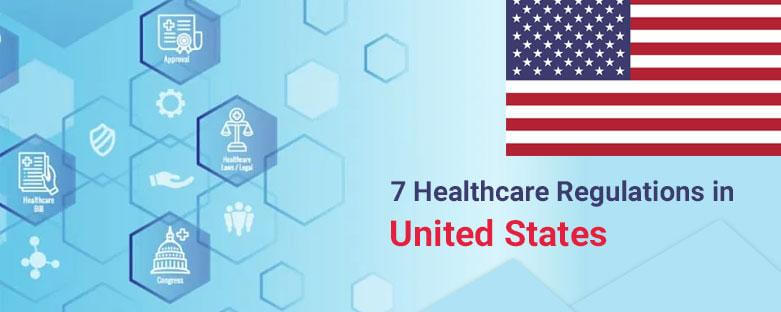7 Healthcare Regulations in the United States
Healthcare regulations With Congressional oversight, United States health agencies have developed several laws to protect Americans’ health and information. In America, The Department of Health and Human Services (HHS) supervises the general health issues and concerns of all American citizens. They perform work such as leading initiatives to improve public health and further medical research. In 2016, HHS decided to improve patient outcomes and reducing medical costs.
Today, federal, state, and even local legislative bodies and regulatory agencies establish rules intended to protect the public, promote access to care, and ensure that medical professionals both adhere to high standards and receive the compensation that is their due.
Here are seven regulations that can affect the delivery and administration of healthcare regulations in the United States daily:
Healthcare Regulations Quality Improvement Act of 1986 (HCQIA):-
The Healthcare Quality Improvement Act (HCQIA) was passed by Congress in 1986. The following points describe the purpose of the HCQIA:
- The national problem about the increasing incidence of medical malpractice and the necessity to improve the quality of medical care.
- There is a national need to restrict the movement of incompetent physicians to move from state to state without disclosure of the physician’s previous damaging or incompetent performance.
- There is a superseding need to offer incentives and protection to physicians engaging in effective, professional peer review.
Medicare:-
On July 30, 1965, President Lyndon B. Johnson signed into law the Social Security Act Amendments, commonly known as the Medicare bill. It is a health insurance program for the elderly aged 65 and older, but also for some younger people with disability status as determined by the Social Security Administration.
Medicare is divided into four parts:
- Medicare Part A covers hospital (formally admitted only), skilled nursing (formally admitted to a hospital for three days), and hospice services.
- Part B includes outpatient services including some providers.
- Part D generally covers self-administered prescription drugs.
- Part C is an alternative called Managed Medicare or Medicare Advantage which lets patients choose health plans with at least the same service coverage as Parts A and B, often the benefits of Part D, and always an annual out-of-pocket spend limit which A and B. A beneficiary must enroll in Parts A and B first before signing up for Part C.
As per the Medicare Trustees Report, Medicare provided health insurance for over 59.9 million individuals among them more than 52 million people aged 65 and older, and about 8 million younger people in 2019.
Medicaid:-
President Johnson in 1965 has signed Medicaid alongside Medicare to provide insurance for low-income individuals. The only difference between Medicare and telemedicine is that the former is for the upper-income class while the latter is for the lower-income group.
Medicaid covers numerous recipients, like uninsured disabled individuals, expectant mothers, and temporarily unemployed workers. Lately, new legislation has lowered the nation’s uninsured rate to under 9-per cent, representing the highest coverage rate in U.S. history.
Today, Medicaid provides coverage for over 70-million American citizens. As of 2014, the program compensated hospitals for almost 50-percent of all medical expenses. Medicaid has completed its 50th birthday in 2015 and celebrated it by posting program highlights, research findings, and the voices of our beneficiaries in 50 days of postings.
Children’s Health Insurance Program (CHIP) in Healthcare Regulations
The Children’s Health Insurance Program (CHIP) previously known as the State Children’s Health Insurance Program (SCHIP), is a program that has created a solid foundation for delivering health coverage to children living in low-income households. The program has an extensive history of providing insurance to underprivileged children and receives funding from respective states and the federal government. It provides low-cost health coverage to children in families that earn too much money to qualify for Medicaid. The program was passed into law as part of the Balanced Budget Act of 1997, and the statutory authority for CHIP is under title XXI of the Social Security Act.
Health Insurance Portability and Accountability Act (HIPAA) of 1996
The Health Insurance Portability and Accountability Act (HIPAA) is perhaps the most well-known medical law. Most people think that HIPAA protects their privacy concerning medical treatment and records. Though, HIPAA goes beyond that. It also provides American workers with the facility to transfer health insurance coverage in case of a change or lose their jobs.
The Act is also associated with the privacy of patient healthcare regulations by establishing boundaries on the use and release of health records. If someone violates the rules of the act then it charges civil and criminal penalties for violations. The law applies to everyone including hospitals, clinics, dentists, chiropractors, psychologists, nursing homes, pharmacies, and healthcare IT companies.
We are aware of the fact that all healthcare regulations that use, store, maintain or transmit patient health information are expected to be in complete compliance with the regulations of the HIPAA law. HIPAA applies to EMR, Telemedicine, EHR, Medical Billing Software, etc. So, Congress decided that additional regulations and stronger penalties were needed to address EHR and cloud-based medical records issues, which further led to the HITECH Act.
Patient Safety and Quality Improvement Act (PSQIA) of 2005
The Patient Safety and Quality Improvement Act was signed into law on July 29, 2005. This act was designed in response to growing concern about patient safety in the United States. The goal of the Act is to improve patient safety by encouraging the reporting of medical errors, at the same time maintaining patients’ confidentiality rights.
To ensure patient privacy, PSQIA offers a patient safety work product that provides Federal privilege and confidentiality protections for patient safety information.
PSQIA has authorized HHS to impose civil money penalties for violations of patient safety confidentiality. PSQIA has also authorized the Agency for Healthcare Research and Quality (AHRQ) to list patient safety organizations (PSOs).
Affordable Care Act of 2010 in Healthcare Regulations
The affordable Care Act, also known as The Patient Protection and Affordable Care Act is sanctioned by president Barak Obama in March 2010. The Act covers complete health insurance reforms along with tax provisions that affect individuals, businesses, families, insurers, tax-exempt organizations, and government entities. These tax provisions hold vital changes and lay down ways how individuals and families file their taxes. The law also encompasses benefits and responsibilities for other organizations and employers.
The main objective of this act is to encourage U.S. citizens to apply for health insurance coverage, levying a penalty for individuals who fail to secure insurance but making exceptions for a few protected groups. If any organization is having more than 200 workers, then the act requires that the company provide health insurance coverage to its employees. The act also established the American Health Benefits Exchange, where citizens can review and compare insurance plans.
With the act, health care professionals can deliver better services to the growing patient population at the same time reducing care expenses.
The Bottomline
VCDoctor offer the Healthcare software solution & HIPAA Compliant Telemedicine Platform to the USA, and South African countries that aim to help healthcare regulations to cope up with innovation in healthcare through specialized solutions and healthcare technology platforms.
With front-line technology, top-notch service quality, we help healthcare providers to focus on delivering quality care rather than running an IT department. That’s why we provide HIPAA-compliant Telemedicine Software development services, EMR, EHR, Medical Billing, Health Information Exchange, Patient Data Management solutions, etc.




